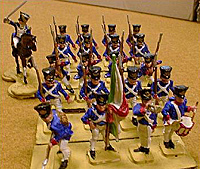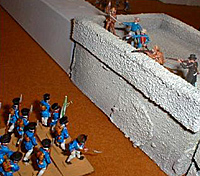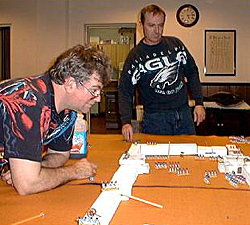 Historical Background: In 1836 Texas was still a part
of Mexico. But the Texans revolted against the autocratic rule
of President Santa Anna. The most famous battle of the Texas War
for Independence occurred at a crumbling old Spanish mission on
the outskirts of San Antonio. Four thousand Mexican soldiers stormed
the walls of the Alamo, killing all of the defenders. Among those
killed were the legendary Davy Crockett and Jim Bowie. Although
this was a defeat for the Texans they won their independence later
at the battle of San Jacinto. Shouting, "Remember the Alamo"
the Texans routed the Mexican army, captured Santa Anna, and secured
their independence. Ten years later Texas joined the United States,
an event that helped ignite the Mexican American War.
Historical Background: In 1836 Texas was still a part
of Mexico. But the Texans revolted against the autocratic rule
of President Santa Anna. The most famous battle of the Texas War
for Independence occurred at a crumbling old Spanish mission on
the outskirts of San Antonio. Four thousand Mexican soldiers stormed
the walls of the Alamo, killing all of the defenders. Among those
killed were the legendary Davy Crockett and Jim Bowie. Although
this was a defeat for the Texans they won their independence later
at the battle of San Jacinto. Shouting, "Remember the Alamo"
the Texans routed the Mexican army, captured Santa Anna, and secured
their independence. Ten years later Texas joined the United States,
an event that helped ignite the Mexican American War.
Davy Crockett reportedly said that the Mexicans would "eat snakes" before they got into the Alamo. This remark seems to capture the defiant spirit of the Texans. These rules were developed for the students in my History Club at Crest Memorial Elementary School in New Jersey. The rules for this battle are adapted from "Remember the Alamo!" by George Knapp, which appeared in MWAN 100. I found the article while browsing on Magweb.com.
The original rules are excellent. For the most part the changes I have made are to simplify the game so that they will work well with my students aged 10-13. The battle can be completed in less than two hours. The Mexicans will suffer a much higher casualty rate than they did historically, but the game moves quickly and is fun. Historically the Texans retreated into the buildings and were blasted out by the Mexicans using the Texan's own cannons. This has been left out of the rules for the sake of simplicity. Although intended for the youngsters our gaming club has enjoyed playing these rules on numerous occasions. I urge you to check out Mr. Knapp's original rules if you are looking for a more detailed battle.
Battle Reports
This game was played twice with the children.
 Battle 1: The Mexicans succeeded in smashing a hole in the
west wall with their cannons. For the main assault two columns
were sent to storm the breach in the wall, two more columns were
assigned to overrun the weak point in the south east corner, and
a fifth column would attack the north wall. Heavy cannon fire
from the Texans halted one of the columns in the west. The second
column reached the wall and began scaling it with ladders before
Jim Bowie and his men threw them back. Bowie was killed in the
melee. The Mexican column in the North made it to the wall easily
but had a terrible time climbing up in the face of fierce resistance.
Eventually they began to wear down the defenders.
Battle 1: The Mexicans succeeded in smashing a hole in the
west wall with their cannons. For the main assault two columns
were sent to storm the breach in the wall, two more columns were
assigned to overrun the weak point in the south east corner, and
a fifth column would attack the north wall. Heavy cannon fire
from the Texans halted one of the columns in the west. The second
column reached the wall and began scaling it with ladders before
Jim Bowie and his men threw them back. Bowie was killed in the
melee. The Mexican column in the North made it to the wall easily
but had a terrible time climbing up in the face of fierce resistance.
Eventually they began to wear down the defenders.
The Mexicans had their greatest success against the log palisade at the southeast corner. Both columns made it to the wall and drove their way into the compound. They suffered terribly from withering rifle fire directed at them from atop the church by Crockett and his Tennessee volunteers. But there were too many Mexicans for the King of the Wild Frontier, and they eventually cornered him and gave him the cold steel. Sensing victory Santa Anna ordered in his reserves. They surprised the Texans by hitting the now lightly defended north west corner. Mexicans poured in from all directions, and the battle was over. The Mexicans had paid dearly for their victory.
Battle 2: This time the Mexicans breached the south wall. Two columns were sent against the breach, two were sent against the northeast corner, and the last column was sent against the palisade. The Mexicans had a difficult time in the early going. The Texan cannons obliterated the column assaulting the palisade. Heavy casualties temporarily halted the columns attacking in the south. But one column managed to close on the northwest corner. A ferocious fight followed as the Mexicans gained a precarious foothold on the walls. As they began to drive back the Texans they relieved the pressure on the second column and soon the Mexicans were sweeping the walls. Crockett led his men in a brilliant fighting withdrawal that exacted a heavy toll on the attackers.
In the south the Mexicans made it to the breach and ran right into Jim Bowie. He rallied his men to stop one column, but was struck down by the flashing Mexican bayonets. The second column followed up and began to force their way through the breach. Santa Anna ordered in his reserves and sent them for the same breach. Col. Travis tried to stem the tide but was killed. Crockett was killed as he tried to get to the church. Soon the Alamo was full of Mexicans hunting down the survivors. It was another Mexican victory, but again the price had been very steep.
 The Armies: I decided to go with 1/72 scale plastic
figures for both armies. Students tend to be rough on figures,
so it doesn't pay to spend a lot of time and money on the miniatures.
The miniatures were painted with my usual quick procedure. After
washing the figures in the dishwasher I primed them with white
spray paint. I painted the flesh, weapons, packs, and other details
using Folk Art acrylic paints. When they were finished the Mexicans
were mounted on pieces of cardboard (four figures in a row). The
Texans were mounted individually on pennies. I dipped the figures
in floor wax to give them a hard finish that will help prevent
paint loss.
The Armies: I decided to go with 1/72 scale plastic
figures for both armies. Students tend to be rough on figures,
so it doesn't pay to spend a lot of time and money on the miniatures.
The miniatures were painted with my usual quick procedure. After
washing the figures in the dishwasher I primed them with white
spray paint. I painted the flesh, weapons, packs, and other details
using Folk Art acrylic paints. When they were finished the Mexicans
were mounted on pieces of cardboard (four figures in a row). The
Texans were mounted individually on pennies. I dipped the figures
in floor wax to give them a hard finish that will help prevent
paint loss.
The Mexicans: I bought six boxes of Airfix 1/72 scale French Infantry Waterloo. This provided enough figures for 58 stands of four Mexicans, including six command stands, and a mounted figure for Santa Anna (with a few leftovers). The Airfix figures are really lousy. I suggest buying a different brand, although the Airfix are cheap (under $4 for a box of 50).
The Texans: One box of IMEX Alamo Defenders gave me 50 nice Texans, including New Orleans Grays, and figures for Crockett, Bowie, and Travis. These are nice figures, and I highly recommend them. The Texan's artillery came from two boxes of IMEX Union and Confederate Artillery. This will give you twelve cannons. I used figures from the Alamo Defenders set as gunners (one per cannon).
Building the Alamo: Following my keep it simple philosophy I made the walls out of empty aluminum foil boxes. These were spray painted white, and some textured paint was used to improve the look. The church was a cardboard box that was given the same spray paint treatment. I used some beach obstacles I had on hand from a D-Day game to represent the palisade in front of the open southeast corner.
Back to SJCW The Volunteer Spring 2001 Table of Contents
Back to SJCW The Volunteer List of Issues
Back to Master Magazine List
© Copyright 2001 by SJCW
This article appears in MagWeb (Magazine Web) on the Internet World Wide Web.
Other military history articles and gaming articles are available at http://www.magweb.com